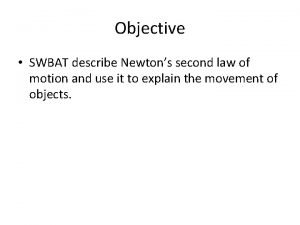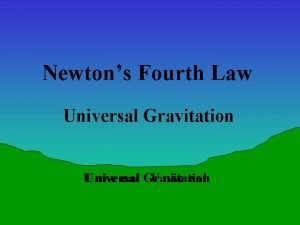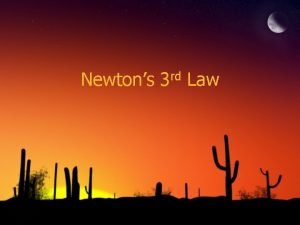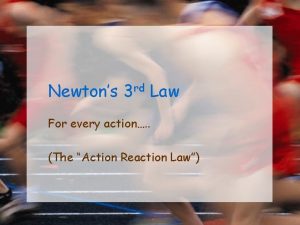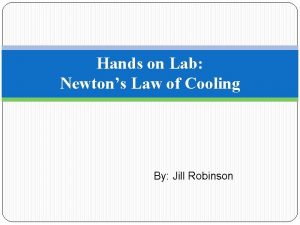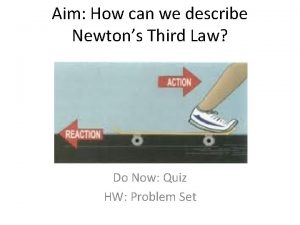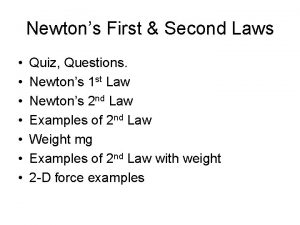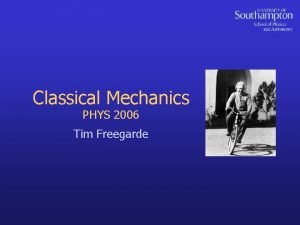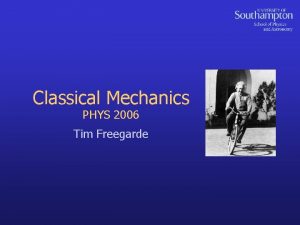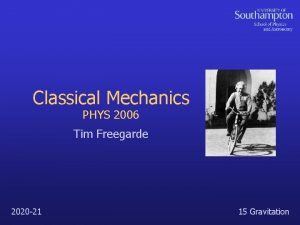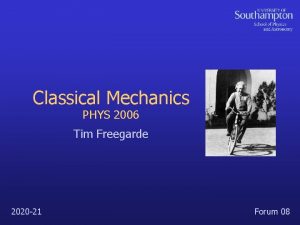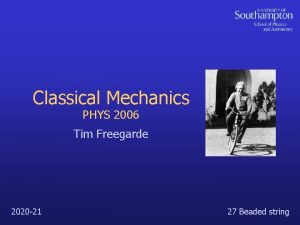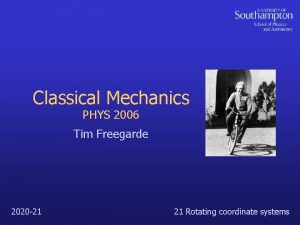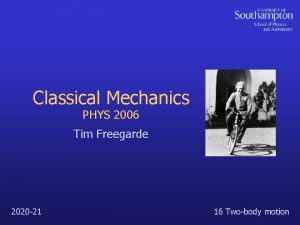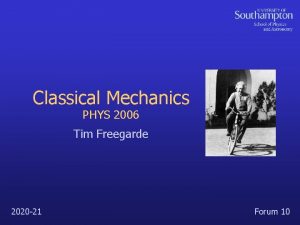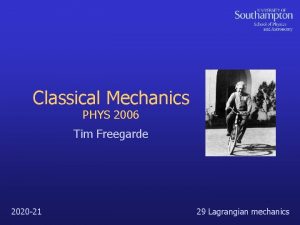Classical Mechanics PHYS 2006 Tim Freegarde Newtons law














- Slides: 14

Classical Mechanics PHYS 2006 Tim Freegarde

Newton’s law of Universal Gravitation • Exact analogy of Coulomb electrostatic interaction • gravitational force between two masses and • gravitational field • gravitational potential 2

Elliptical orbit • eccentricity • constant • semi latus rectum • polar equation • Cartesian equation • semimajor axis • semiminor axis • total energy 3

Conic section orbits • eccentricity • constant • semi latus rectum • polar equation • Cartesian equation • semimajor axis • semiminor axis • total energy 4

Conic section orbits http: //www. personal. psu. edu/smh 408/ 5

Conic section orbits Alastair Rae 6

Conic section orbits Magnus Manske 7

Kepler’s laws 1. Planetary orbits are ellipses with the Sun at one focus 2. The radius vector from Sun to planet sweeps out equal areas in equal times 3. The square of the orbital period is proportional to the cube of the semimajor axis 8

Conic section orbits • eccentricity • constant • semi latus rectum • polar equation • Cartesian equation • semimajor axis • semiminor axis • total energy 9

Planetary orbit 1. Planetary orbits are ellipses with the Sun at one focus 2. The radius vector from Sun to planet sweeps out equal areas in equal times 3. The square of the orbital period is proportional to the cube of the semimajor axis 10

Effective potential • angular momentum conserved where • effective potential for radial motion 11

Yukawa potential HIDEKI YUKAWA (1907 -1981) • angular momentum conserved where YUKAWA POTENTIAL • attraction between nucleons • precession of perihelion • distinct allowed regions for small E • alpha decay 12

Three-body problem • notoriously intractable • chaotic motion: • tiny difference in initial conditions results in very different trajectory • total energy conserved • angular momentum not conserved, since torque required to hold stars in place STARS OF EQUAL MASS, FIXED POSITIONS 13

Classical Mechanics LINEAR MOTION OF SYSTEMS OF PARTICLES centre of mass Newton’s 2 nd law for bodies (internal forces cancel) rocket motion rotations and infinitessimal rotations ANGULAR MOTION angular velocity vector, angular momentum, torque parallel and perpendicular axis theorems rigid body rotation, moment of inertia, precession conservative forces, law of universal gravitation GRAVITATION & KEPLER’S LAWS 2 -body problem, reduced mass planetary orbits, Kepler’s laws energy, effective potential NON-INERTIAL REFERENCE FRAMES NORMAL MODES centrifugal and Coriolis terms Foucault’s pendulum, weather patterns coupled oscillators, normal modes boundary conditions, Eigenfrequencies 14
 Newtons 3 rd law of motion
Newtons 3 rd law of motion Newtons second law in soccer
Newtons second law in soccer Describe newtons second law
Describe newtons second law Newton's first law of motion
Newton's first law of motion Newton's fourth law
Newton's fourth law Newtons 3 rd law of motion
Newtons 3 rd law of motion Newtons 3 laws
Newtons 3 laws Newton's 3 law
Newton's 3 law Newtons 3 rd law
Newtons 3 rd law Newton’s cooling law
Newton’s cooling law Describe newtons third law
Describe newtons third law Third law of thermodynamics derivation
Third law of thermodynamics derivation Difference between weight and mass
Difference between weight and mass Newton’s 3rd law
Newton’s 3rd law Newtons 3 laws quiz
Newtons 3 laws quiz


